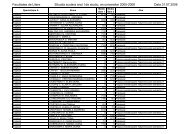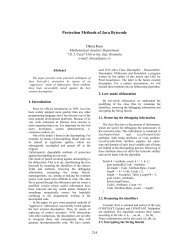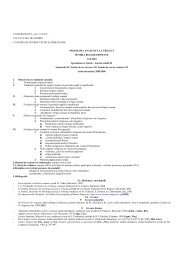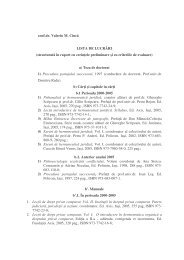GigabitEthernet Testbed over Dark Fiber
GigabitEthernet Testbed over Dark Fiber
GigabitEthernet Testbed over Dark Fiber
- No tags were found...
Create successful ePaper yourself
Turn your PDF publications into a flip-book with our unique Google optimized e-Paper software.
3. Monitoring Gigabit Interfaces<br />
Monitoring the Gigabit interface.<br />
To monitor with SNMP a highly loaded gigabit<br />
interface in a Cisco Catalyst 3550 it is necessary to<br />
take in consideration that they have just 32 Bit<br />
SNMP counters. If the interface is fully loaded with<br />
1 Gigabit/s traffic the counter resets every 34<br />
seconds.<br />
(2^32 * 8) / 10 9 = 34.35 second<br />
In consequence it is necessary to poll the<br />
interface at least every 30 seconds. Taking in<br />
consideration that when the switch is heavily loaded<br />
the switch can't respond to the SNMP request in<br />
time we have decided to poll the interface every 20<br />
seconds.<br />
The monitoring machine was a RedHat Linux<br />
2.4.19, using UCD-SNMP version 4.2.4 to fetch the<br />
data, and RRD-tool 1.0.40 to store and graph the bit<br />
rates and packet rates. Because in CRONTAB we<br />
can't setup to run the data fetching script every 20<br />
seconds we used the following script:<br />
#!/bin/bash<br />
while true; do<br />
/var/local/flows/giga-test/scripts/snmp-datastore<br />
sleep 20<br />
done<br />
The snmp-data-store script pools the gigabit<br />
interface and store the data in rrd's.<br />
IN=$(snmpget 217.73.171.3 public 2.2.1.10.26 |<br />
awk "{print \$4 ;}")<br />
OUT=$(snmpget 217.73.171.3 public<br />
2.2.1.16.26 | awk "{print \$4 ;}")<br />
INpk=$(snmpget 217.73.171.3 public<br />
interfaces.ifTable.ifEntry.ifInUcastPkts.26 | awk<br />
"{print \$4 ;}")<br />
OUTpk=$(snmpget 217.73.171.3 public<br />
interfaces.ifTable.ifEntry.ifOutUcastPkts.26 |<br />
awk "{print \$4 ;}")<br />
DATA=`date +%s`<br />
rrdtool update /var/local/flows/gigatest/rrds/c3550.rrd<br />
$DATA:$IN:$OUT:$INpk:$OUTpk<br />
Every 5 minute one script create the graphic in<br />
the form of a GIF picture.<br />
To visualize the bit rates we use the following<br />
rrdtool command:<br />
rrdtool graph gigabits20.gif \<br />
--start -86400 -t "Giga 20 sec" \<br />
-w 600 -h 400 --base 1000 \<br />
DEF:i=c3550.rrd:in:AVERAGE \<br />
CDEF:inb=i,8,* \<br />
DEF:o=c3550.rrd:out:AVERAGE \<br />
CDEF:outb=o,8,* \<br />
CDEF:outbn=outb,-1,* \<br />
AREA:inb#00ff88:"IN traf" \<br />
COMMENT:Min \<br />
GPRINT:inb:MIN:%lf%s COMMENT:bps<br />
\<br />
COMMENT:Average \<br />
GPRINT:inb:AVERAGE:%lf%S<br />
COMMENT:bps \<br />
COMMENT:Max \<br />
GPRINT:inb:MAX:%lf%s<br />
COMMENT:bps \<br />
AREA:outbn#ff8800:"Out traff" \<br />
COMMENT:Min \<br />
GPRINT:outb:MIN:%lf%s<br />
COMMENT:bps \<br />
COMMENT:Average \<br />
GPRINT:outb:AVERAGE:%lf%S<br />
COMMENT:bps \<br />
COMMENT:Max \<br />
GPRINT:outb:MAX:%le%s<br />
COMMENT:bps \<br />
HRULE:0#000000<br />
4. Tests<br />
4.1 Connectivity test<br />
Before any exhaustive test could begin we had to<br />
test connectivity between the two switches.<br />
The estimated distance of 110km is slightly <strong>over</strong><br />
the 100km range of the product but fortunately after<br />
connecting the optical fiber the connected LED lit<br />
up. CDP also showed the other end switch.<br />
4.2 Layer 3 connectivity test<br />
After some basic configuration a IP connectivity<br />
test could be performed and ping reported 2 ms.<br />
After configuring a routing loop and injecting<br />
some traffic, interface utilization was brought up to<br />
<strong>over</strong> 95%. Ping reported an average 15 ms and still<br />
with no packet drops. The switch and interfaces are<br />
performing quit well.<br />
4.3 Monitored Heavy load test<br />
50









